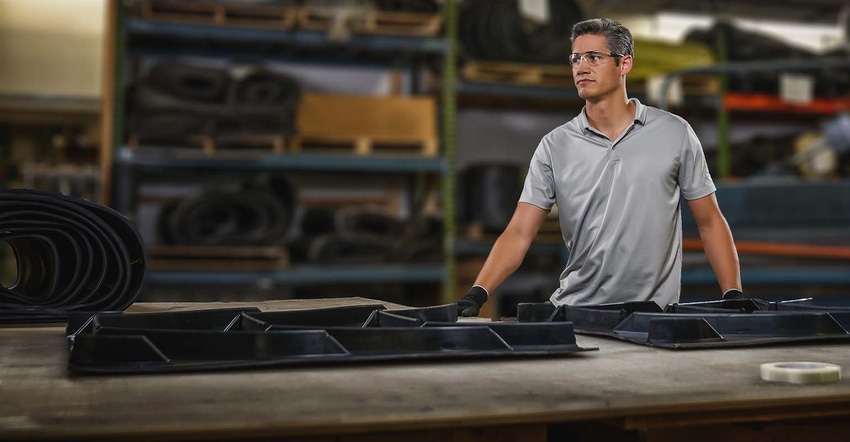April 24, 2019

Every piece of a machine in the field has value to a farmer, but often there are parts you don’t think about – until they break. Consider the conveyor belt, which may not be seen as a key component of a machine, yet it in many applications it’s a critical wear part and when it breaks you’re down.
Mike Schroeder spends a lot of time thinking about conveyor belts and belt technology. He has to; he’s involved in product development with WCCO Belting, a Wahpeton, N.D., firm that makes rubber products both for original equipment and aftermarket support. “We find that when we talk with a manufacturer about the belt itself it’s often the last thought they have when they design and develop a conveyor,” Schroeder says. “Of course, the first thing they recognize is that when that belt breaks the whole system shuts down.”
Schroeder doesn’t operate as if he’s the beleaguered supplier that gets no respect. For him, and WCCO Belting, the mission is to educate engineers and designers about the importance of using the right material and design for a belt. The goal is to provide the right durability and performance to fit the job and cost of the machine. No easy task.
“We have a lot of OEMs we have worked with for a long time,” Schroeder says. “It’s critical to understand the conveying process and how it works.” In equipment design there’s often give and take between manufacturer and supplier, working to find the right balance of durability and performance without breaking the bank on the final cost of the machine.
WCCO Belting is what I would call “basic” in conveyer technology. The company is working from very raw material to finished product in its factory. They can form the belt from rubber, matching it to the right fabric during processing and put the belt through vulcanization, a process that turns soft rubber into a durable performance material.
Innovation and belting
As a writer covering equipment, I’m pretty sure when a farmer thinks new technology or innovative design the first thought isn’t to the belt running inside that conveyor or other application. This is a product you think about only when it breaks. “That’s the thing, I feel there is a lot of commodity type belting on the market and in the conveyor the belting may be an afterthought,” Schroeder says.
Yet proper belt design and manufacturing can really make a difference. For example, in the potato harvest industry, conveyors are the lifeblood in the process of moving the spuds from field to storage. In potato facilities “chains” of conveyors move those products through the sorter and into proper storage, but for one company the belts were failing.
Schroeder explains that the belts were “rolling over” or folding over on itself, and when that happens, the conveyor has to shut down. It was the weight of the potatoes combined with the conveyor belt design. The challenge was to stop the folding from happening without making the belt thicker, which could boost energy usage, and impact wear and tear on other parts of the conveyors.
That’s where Schroeder says his company’s ability to design and manufacture belting from scratch became an asset. They designed a belt that remained flexible, but through some design features the belt was made rigid as a board horizontally. “This belt has a thin profile, and is being side loaded at 90-degrees, and while it will still slide, it no longer folds,” he says. “That little change, which involved the fabric of the carcass, which is not new to the global conveyor industry but was new to ag, made a difference.”
More innovation
WCCO Belting goes beyond design innovation when working with partners. The company is also looking at the bigger picture of rubber use and belt design. One area of material science the company is deploying is TerraTech . A product line of rubber products that uses sustainable materials, the first technology being rubber made from soybean oil. “We were looking at soybean oil, wanted to research ways it could be used in the belt, and found success,” he says.
Schroeder says the base material science in its soy oil rubber technology can be deployed in almost any belt the company makes, enhancing the potential for soy oil use in the industry and opening a new market for growers. In addition, the company has other products made with sustainable materials under the TerraTech line in testing. The entire effort innovates conveyor belting and aims toward a greener product for the industry.
The TerraTech brand of rubber products are new technologies WCCO Belting is working into the market. And it shows that even something so “ignored” as a conveyor belt can contain quite a bit of technology and innovation.
About the Author(s)
You May Also Like






